Wandering jew plants are fun to grow, and there are lots of different varieties that all require the same care.
Also known as “inch plant” or “wandering dude”, they are much loved for their unique bright colors, and their vining growth habit.
This comprehensive care guide will show you everything you need to know about how to grow Tradescantia, including water, light, soil, fertilizer, pest control, and much more.
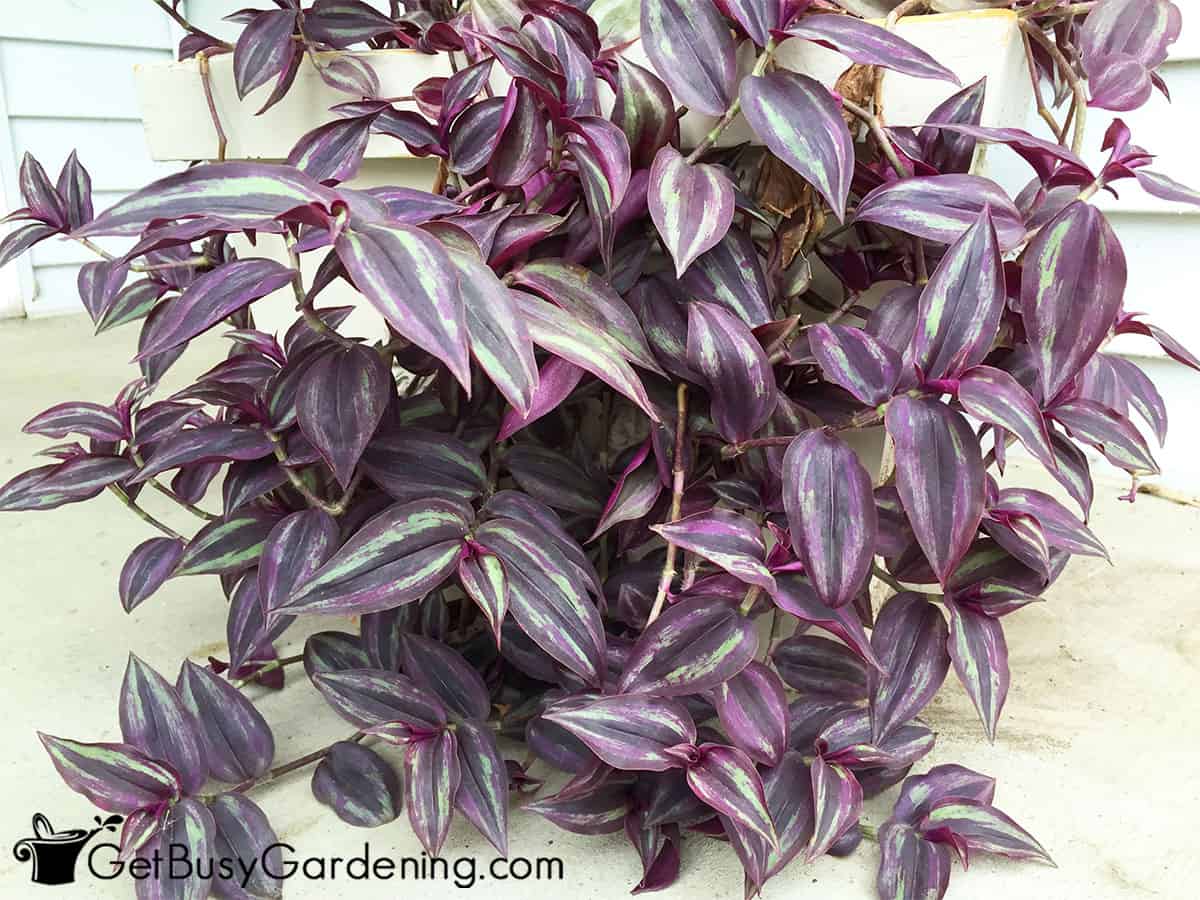
Wandering Jew Care Overview
| Scientific name: | Tradescantia |
| Classification: | Tropical plant |
| Common names: | Wandering jew, wandering dude, inch plant |
| Hardiness: | Zones 9-11 |
| Temperature: | 50-80°F |
| Flowers: | Light purple, white, or pink |
| Light: | Partial to full shade |
| Water: | Consistently moist, do not overwater |
| Humidity: | High to average humidity |
| Fertilizer: | General purpose in spring and summer |
| Soil: | Houseplant potting soil |
| Common pests: | Spider mites, aphids, fungus gnats |
Information About Wandering Jew Plants
Wandering jews (Tradescantia, aka “inch plant” or “wandering dude”) are trailing tropical plants which are originally native to Mexico. They’re commonly sold as annuals in cold climates, but they are actually tender perennials.
When you hear their name, you might think about the classic variety with purple and silver variegated leaves (Tradescantia zebrina).
But the same common names refer to a whole family of plants that fall under the scientific name of “Tradescantia”.
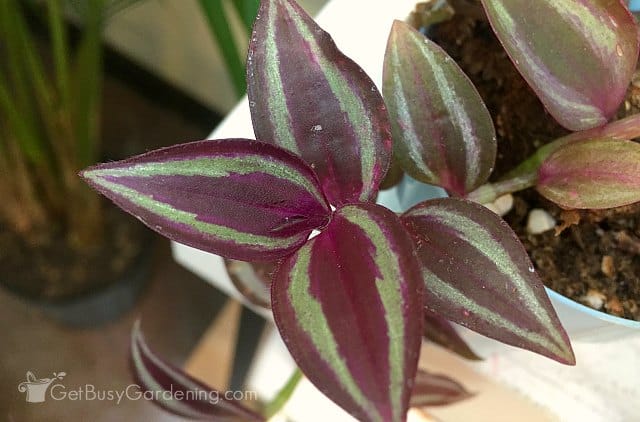
Different Wandering Jew Varieties
There are a whole bunch of different types of tradescantia plants you can grow, and they all require very similar care.
Here’s a list of the most common varieties. Be sure to take a look at the pictures throughout this post to see what some of them look like.
- Bolivian (while this is called “wandering jew”, it’s actually a different species)
- Bridal veil
- Red burgundy
- Purple fuzzy leaves
- Green fuzzy leaves
- Tricolor (‘Nanouk’)
- White/green variegated
- Purple queen (aka: purple heart)
Related Post: 17 Beautiful Purple Houseplants To Liven Up Your Home
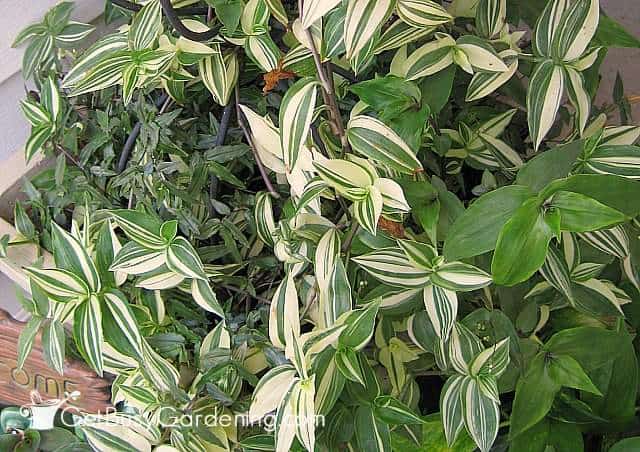
Toxicity
According to the ASPCA website, Tradescantia can be toxic to both cats and dogs. So, for your pet’s safety, it’s best to keep this one out of their reach.
Hardiness
Though they look extremely delicate, wandering jews are hardier than you might think, and can survive in zones 9-11.
They are not tolerant of the cold for very long, and will die at the first hard freeze if left outdoors. But, they can easily be brought indoors and grown as a houseplant through the winter.
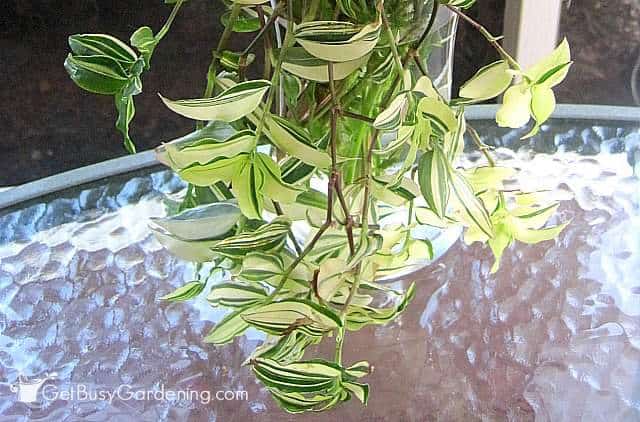
Where To Grow Wandering Jews
Before we get into the details of wandering jew plant care, it’s important to know a few key things about where to grow them to be successful.
Outdoors
I find it much easier to move my plants outside for the summer. I put them on my shady front step, where they thrive and get huge. I have two large containers with obelisks in them that are perfect.
As the vines grow longer, I train them to climb the supports. By mid-summer they are absolutely gorgeous, and I get tons of compliments on them every year.
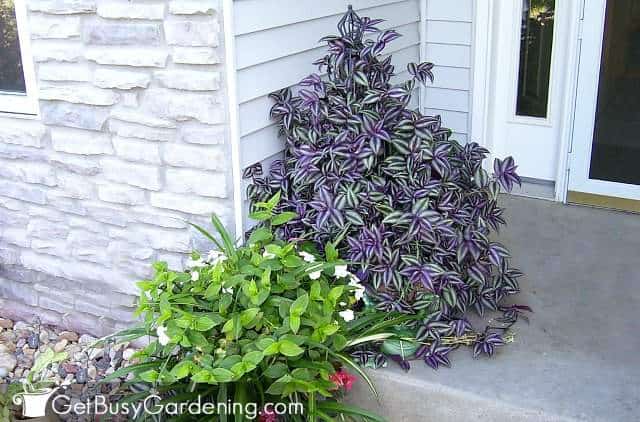
Indoors
Before frost hits in the fall, I bring my wandering jew plants inside, and keep them growing as houseplants.
Growing them indoors through the winter can be a bit difficult. But given the right care, you can keep your inch plant thriving year after year – which is totally worth it if you ask me.
If your plant is large, you could take cuttings and grow them in a vase of water. They won’t live that way forever, but if you keep the water fresh, they’ll be fine for several weeks.

Wandering Jew Plant Care & Growing Instructions
Despite their differences, all varieties of wandering jew plants have the same basic care requirements. So you can follow these growing instructions for any type that you have.
Water
Tradescantias like to be watered regularly, and won’t tolerate their soil drying out for very long.
Keep the soil evenly moist (but never soggy) at all times. Give them a deep drink, and allow the excess to drain from the bottom of the pot.
They will tolerate being overwatered once in a while, but never allow the soil to stay wet for too long. If you struggle to give yours the right amount, I recommend getting a moisture probe to help you out.
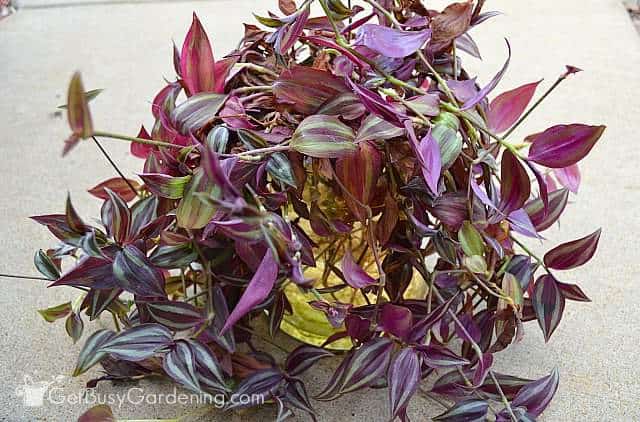
Humidity
Another key part of successful wandering jew plant care is humidity, and lots of it. When the humidity is too low, the leaves will start to turn brown and die.
This is the biggest issue with growing them indoors during the winter months, when the air in our home is super dry. So, it’s very important to keep the humidity as high as possible.
One easy way to increase the humidity level is to run a humidifier nearby. You should also keep an indoor humidity monitor next to your inch plant.
You could also put the pot on a pebble tray filled with water (don’t allow it to soak in it though), or even grow it in a small plant cloche or a mini indoor greenhouse.
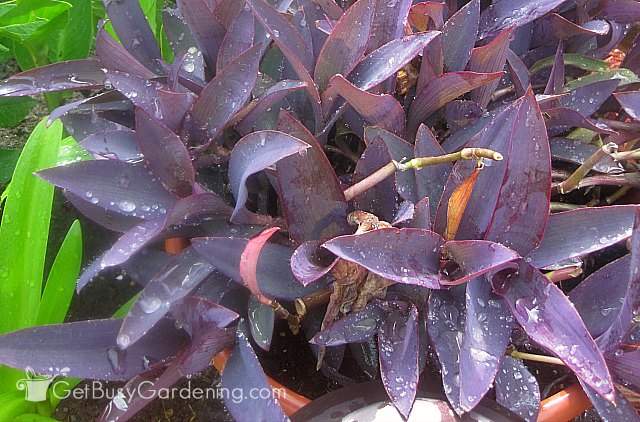
Light
Wandering jews are pretty picky about getting the right amount of light. They need a lot of light to maintain their bright color, but direct sun will burn their leaves (except for purple queen, they love full sun).
The ideal location for growing them indoors is an east or west facing window. That way it will get plenty of natural light in the morning/evening, and bright, indirect sun for the rest of the day.
When they don’t get enough light, their leaf colors will fade and look dull. So, if you don’t have a spot with lots of natural sun, then you should add a grow light.
But if you choose to move your inch plant outside for the summer, make sure to keep it in the shade or a partial shade location where it’s protected from the hot afternoon sun.
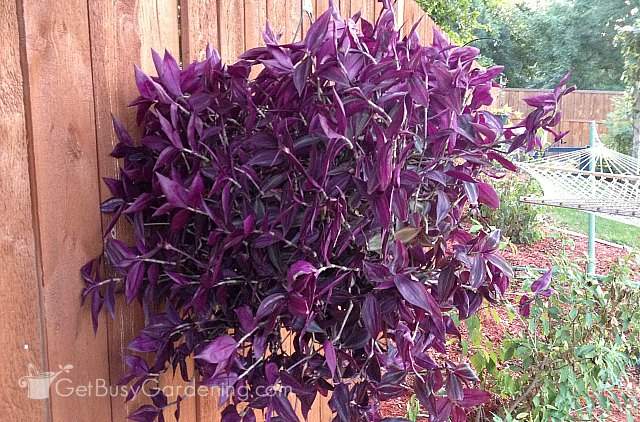
Temperature
Though wandering jews can tolerate short periods of extreme cold or hot temperatures, they grow best when kept between 50-80°F.
When it gets too far out of that range, the plant may start to suffer. It can handle warmer temps with shade, higher humidity, and consistent watering.
But if the forecast calls for frost or a short burst of freezing weather, either move it indoors, or cover it to protect the foliage from damage.
Soil
When it comes to soil, wandering jew plants aren’t picky, they will grow just fine in a general purpose mix.
But if you tend to forget to water (been there, done that), or the soil dries out too quickly, then mix in some peat moss, coco coir, and/or vermiculite to help it retain moisture.
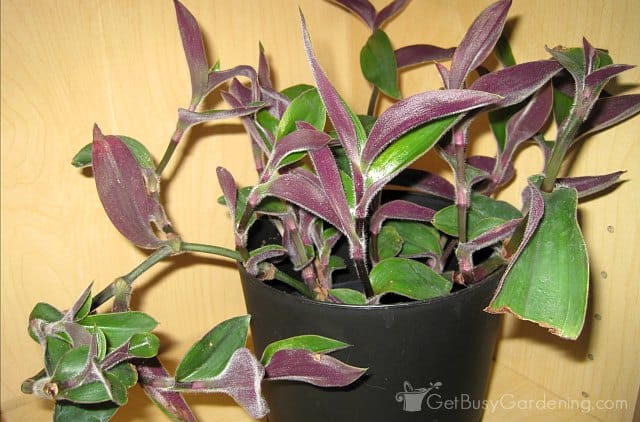
Fertilizing
Inch plants don’t really need to be fertilized as a part of their regular care. But of course they will benefit from being fed once in a while.
They only need it spring through summer, don’t fertilize them in the fall or winter. Winter growth is usually very weak and leggy, so you really don’t want to encourage that.
You can feed your plant monthly with a liquid fertilizer mixed at half strength. I recommend using organic plant food, rather than a synthetic one. Wandering dudes can be sensitive to chemical fertilizers.
A good organic general purpose fertilizer, or compost tea would work great. You could also add slow-release organic granules to the soil if you prefer doing that.
Fish emulsion and liquid kelp are also great options, but only use these outdoors (they can get a bit stinky when used indoors).

Repotting
When given the proper care and the perfect environment, wandering jews will fill a container fairly quickly. So you may need to repot them annually.
If yours becomes pot-bound or you see roots either coming out the bottom holes or growing over the top of the soil, it’s time to size up.
Choose a container that’s 1-2″ larger than the current one, and replant it at the same depth.
Wandering Jew Plant Flowers
Fertilizing can also help encourage blooming. Wandering jew flowers are pretty small and insignificant, and not all varieties look the same.
The flowers can be purple, pink, or white, and it’s always fun to see them. Sometimes they will even bloom during the winter, which is a welcome surprise.
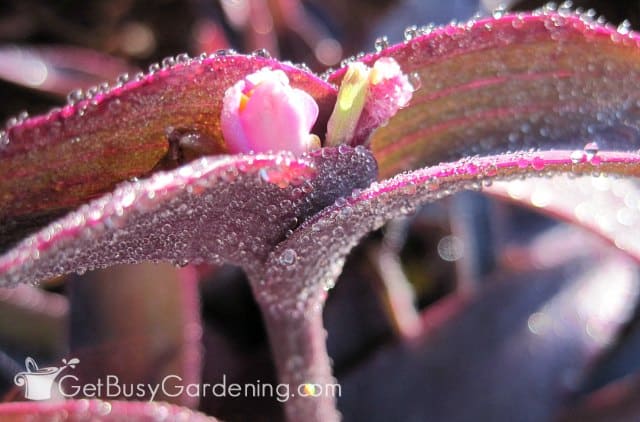
Pest Control
Bugs aren’t usually an issue when growing wandering jews outdoors. But spider mites, aphids, and fungus gnats can become a problem indoors.
To fight houseplant pests that infest the leaves, I recommend using neem oil, which is a natural pesticide.
I also like to use a mixture of 1 tsp mild liquid soap per 1 liter of water, and spray it on the leaves to kill the bugs. Insecticidal soap or horticultural oil also work great.
If you see gnats flying around your inch plant, allow the soil to dry out a bit more between waterings. You can also use a yellow sticky trap to help control them.
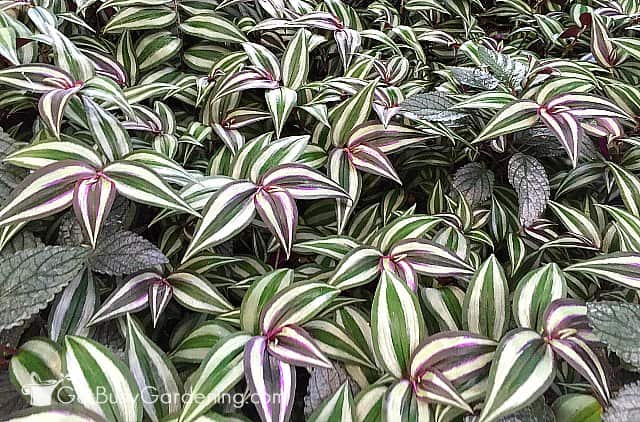
Pruning
It’s a good idea to make pruning a part of your wandering jew plant care schedule. Doing so will keep the vines compact and thick, giving it an overall fuller shape.
Trimming them encourages new growth, so it’s best to do it during the spring and summer months only, to avoid legginess. You can prune off dead and dying stems and leaves at any time.
For precision cuts, I recommend using bonsai shears or a micro-tip snip. You may also want to wear gloves, as the sap can be irritating for people with sensitive skin.
Learn more and get my detailed step by step wandering jew pruning instructions here.
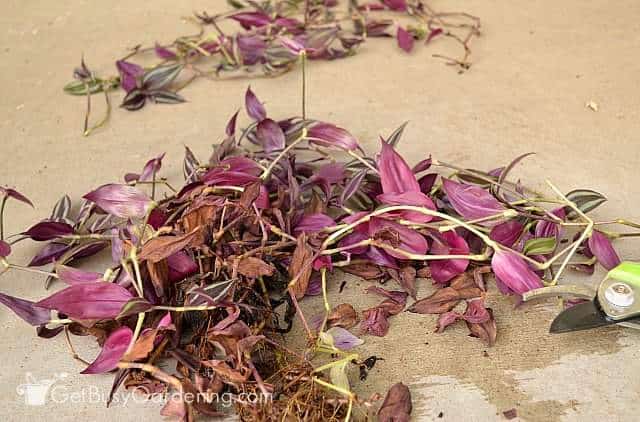
Tips For Propagating Wandering Jew Plants
Wandering jew plants are super easy to propagate. Take cuttings that are 3-4″ long, and include a couple of leaf nodes.
Dip the cut ends into rooting hormone, then stick them in moist soil. Don’t allow the soil to dry out, and keep the air around the cuttings humid. A propagation chamber makes this simple.
They are also simple to root in a vase of water, and you’ll start to see new roots in a matter of days. I like to use a clear vase so I can see when the roots start to form.
Learn more in my step by step guide for how to propagate a wandering jew plant here.
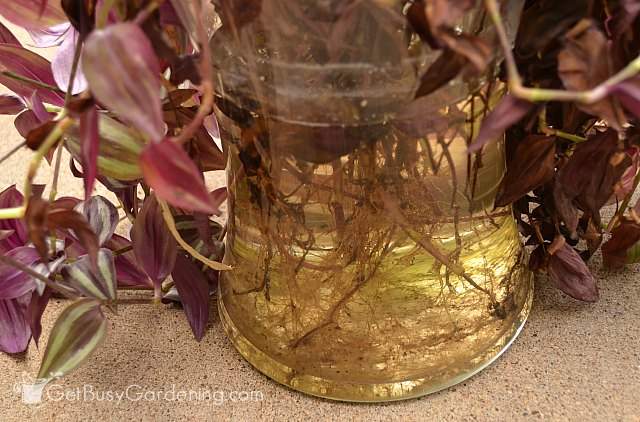
Troubleshooting Wandering Jew Plant Care Problems
It’s super easy to grow wandering dude plants outside, especially when it’s humid. But growing them indoors is a whole different story.
Most of the problems you’ll have with indoor care will be due to inadequate water, light, and/or humidity.
Weak, Leggy Growth
This is very common during the winter months, and is caused by a lack of light. Check the location of your wandering jew to ensure it’s getting the right amount of sun, or add a grow light.
Leaves Look Dull & Faded
Dull, faded leaves can be caused by too much light, not enough light, or a bug infestation.
Outdoors keep them in a partial to full shade location, and indoors give them bright, indirect light.
Another possible culprit is pests. Inspect the leaves for bugs and treat any insect infestation right away.
Brown Leaves
The leaves tend to turn brown due to lack of water or humidity. Make sure to keep the soil evenly moist at all times, and mist them regularly if the air is dry.
Also, as Tradescantia plants age, they tend to start dying out in the middle. When this happens, you can prune the vines and dead leaves to refresh the plant.
Learn more about what causes brown leaves and how to fix them here.
Yellow Leaves
When the leaves turn yellow, it’s almost always due to overwatering. Check the soil to make sure it’s not wet or soggy.
If it’s too wet, then let it dry 1″ down before watering it again. Use a moisture gauge to help you get it right.
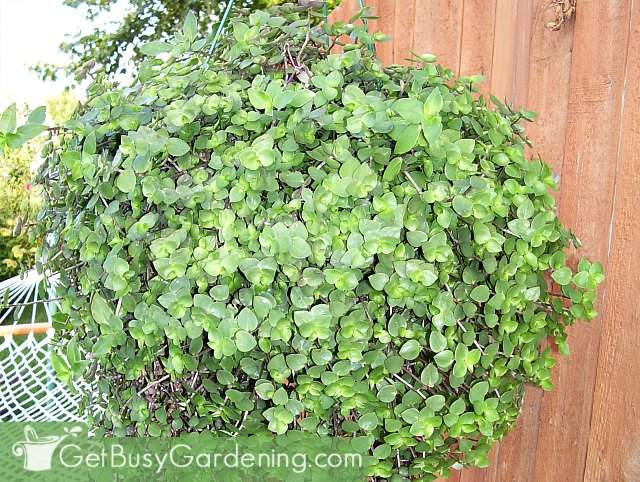
FAQs
When given the proper care, wandering jews are not hard to grow. They can be challenging as houseplants however. So for best results, put them outside during the summer, and overwinter them indoors.
A wandering jew can be either an indoor or an outdoor plant. If you live in zones 9-11, you can grow it outside all year. Otherwise, you’ll need to bring it inside during the winter.
You should water your wandering jew plant only when it needs it, rather than doing it on a set schedule. Check the soil weekly, and give it a deep drink when it feels dry 1″ down.
Wandering jews like full to partial shade rather than sun, especially in hot climates. Indoors they need lots of bright, indirect light.
You can make your wandering jew fuller by pruning it regularly during the spring and summer months. Simply cut the vines to the desired length, then they will branch out and come back much fuller.
If you want to learn all there is to know about maintaining healthy indoor plants, then you need my Houseplant Care eBook. It will show you everything you need to know about how to keep every plant in your home thriving. Download your copy now!
More Houseplant Care Guides
- How To Care For Indoor Palm Trees And Plants
- How To Care For Rubber Plants: The Ultimate Guide
- How To Care For A Pothos Plant (Devil’s Ivy)
- How To Care For A Money Tree Plant (Pachira aquatica)
- African Milk Tree: How To Grow & Care For A Euphorbia trigona Plant
- How To Care For Foxtail Fern (Asparagus densiflorus ‘Myers’)
Share your wandering jew plant care tips in the comments below.



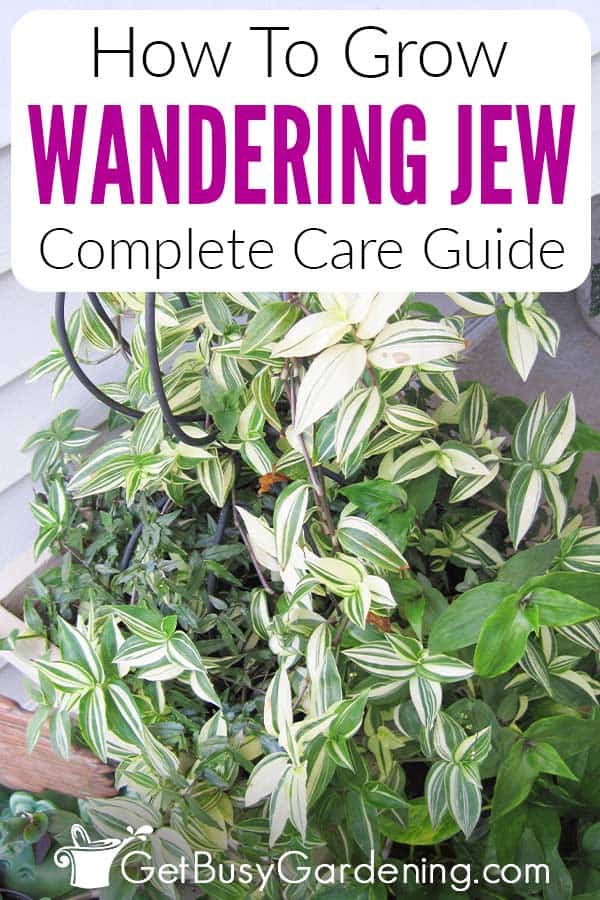
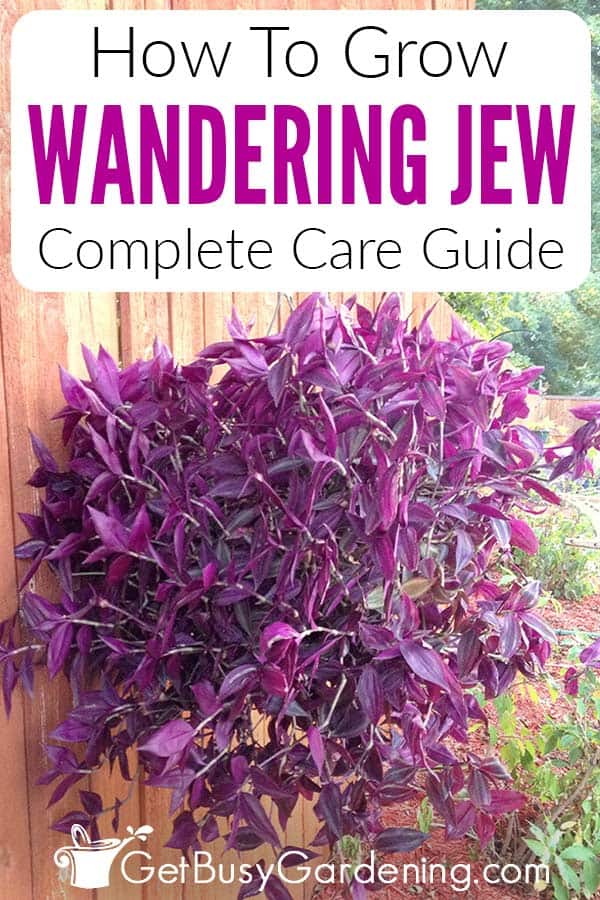
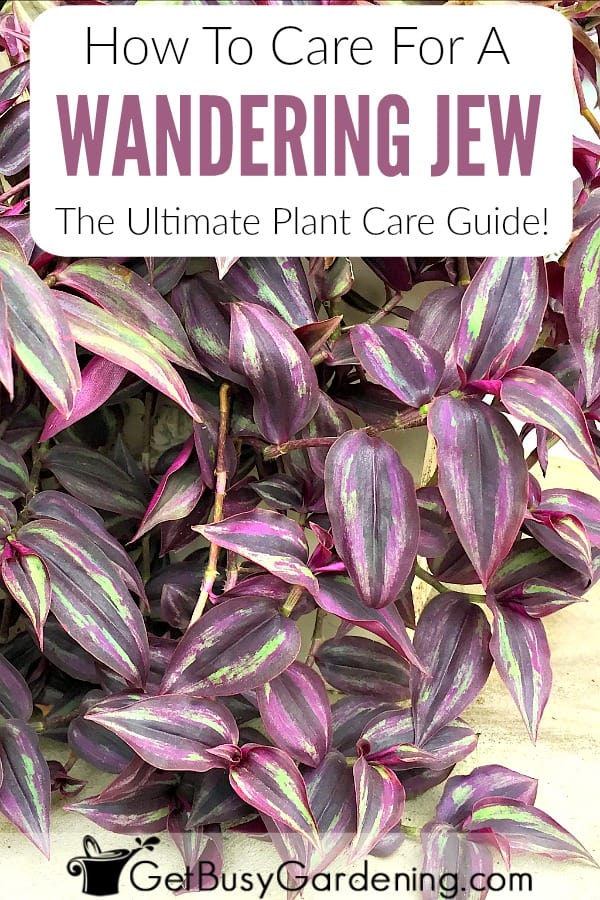



Meagen Joseph says
I bought a sad looking green and purple wandering Jew and having moved from a very hot climate to a dry and cold climate I was uneducated to the care of this beauty but your tips help me save the poor thing I now have a pretty little family starting over and I can’t wait to see them flourish. Thank you for your knowledge.
Amy Andrychowicz says
Wonderful to hear! So glad you were able to save your wandering jew, and now it’s flourishing! You’re welcome, glad I could help. 🙂
Cathy says
Hi, this article is very informative. I couldn’t find the answer to my question, so I thought I would ask. When I water my purple wandering Jew plant, the water runs out quite dark brown out of the bottom of my hanging planter. Does this sound like it needs to be reported or watered less? I usually just water when the soil feels dry to the touch, but maybe I am pouring too much in? Thanks!
Amy Andrychowicz says
There’s no concern about the water being brown when it drains out the bottom of the pot. It just means the nutrients are leaching out of the soil, which is totally normal for potted plants. As long as your wandering jew is growing great, then there’s no need to repot it.
Lewis Messer says
I have a massive purple silver wandering jew in my office. I water it twice a week and it is thriving. Everyone that comes into my office comments on it and all want a cut-ling, lol. I have 5 or 6 cut-lings in water at all times to hand out to folks. I give them a few tips about lighting and watering them. So far people love them.
Amy Andrychowicz says
Wonderful! Sounds like you have the perfect touch for caring for your wandering jew! Love to hear that you share cuttings with your co-workers. That’s so much fun, and I bet they love it too!
Ernie Marotta says
I have a wandering jew out doors in central Fl. Can it take temperatures below 35degress.
Amy Andrychowicz says
Yes, wandering jews are hardy in zones 9-11, and can handle temps down into the 20sF.
Dee says
I would like to know the variety of wandering jew that is all purple. But not the purple heart. It is in a hanging basket in the picture. Picture is directly above the best potting soil section. Thanks!
Amy Andrychowicz says
I believe that wandering jew variety is called ‘Red Gem’. I’ve also heard it called ‘Red Burgundy’. It was hanging in a location where it got late afternoon through evening sun, so that’s why it is so purple in that photo.
Anita says
I have found yellow powdery spots on my wandering Jew leaves. I can brush them off very easily but they reoccur and I have not been able to find any information about this on any website. I would appreciate any attention you can give to this matter. The plant is very large and it’s quite healthy other than these powdery spots.
Amy Andrychowicz says
Oh no, sorry to hear your wandering jew leaves have spots on them. The first thing to do is take a close look to make certain they aren’t mealybugs, because they look like mildew on a plant leaves. Otherwise it could be a type of mold, or perhaps powdery mildew. If that’s the case, then the leaves are too wet. If your wandering jew is inside, then don’t mist it and be sure to water it at the base rather than over the top of the leaves. If it’s outside, then move it to a spot where it’s protected from rain so the leaves can dry off.
Renee Mitchell says
I have a purple one out side and something is eating it can you tell me what to do
Amy Andrychowicz says
Can you tell if it’s a bug or an animal that’s eating your wandering jew plant? Check out the section above titled “Pest Control For Wandering Jew Houseplant” to see if that will give you the info you’re looking for. Otherwise, let me know what’s eating your plant so I can give you better tips. 🙂
Renee Mitchell says
Im not sure but they are large bites i thought it might be a lizzard but not sure
Aysha says
Thank you! Super super useful 🙂
Amy Andrychowicz says
You’re welcome! 🙂
Bobbie says
I received six wandering jews, ordered online. They are leggy and not full. Is there a way to revive?
Amy Andrychowicz says
Yes, you can prune your wandering jew plants, and then propagate the cuttings. It’s super easy to root wandering jew cuttings. See the “Pruning Wandering Jew Plants” and “Wandering Jew Plant Propagation” sections above for details.
Sasha says
I recently just discovered Wandering Jews and I love them! I found a thick, fleshy green version by the river bank across the street from my house! I definitely brought some home. But my burning question is what’s the dark leaved plant in the photo with the Wandering Jew? The photo under “Pest Control”? I’m not sure how old this article is but I have dozens of those plants and been searching the internet forever trying to find the name of it is 38th now luck. I hope to finally find out some proper information on it. Anyways, great article! Definitely bookmarking! 🙂
Amy Andrychowicz says
Awesome, I love wandering jew plants too! You must live in a warm climate if they grow wild near your house. They are definitely not cold hardy. The plant you’re asking about is a dark purple pilea plant.
Angela says
It appears to be a type of coleus, that you see with the wandering new in the pesticides photo.
Daniela Kinslow says
I use wandering jew cuttings as filler in my outdoor flower boxes. In the fall I dig up the resulting plants, put them in a big pot and grow them inside for the winter. In the spring I take cuttings again for filler. Last spring I took the cuttings I needed for filler and stuck the rest in a new pot to have a fresh new plant. It filled out beautifully, then suddenly all of the new growing tips got thin, wrinkly brownish leaves. The older leaves are fine but the plant stopped growing. I don’t see any bugs.
Amy Andrychowicz says
It sounds like your wandering jew plant isn’t getting enough light and humidity. Lack of light causes the new growth to be weak and spindly, and lack of humidity causes the leaves to turn brown.
Ran says
Thanks for the tips!
I have a further question, you’ve mentioned that if a cutting was propagated in water it might get a shock when returned back to soil.
I have a problem with that, about a year ago I found a broken cutting of purple heart in the street, I saved it and took it home, I didn’t know that it can be planted directly in soil, so I put it in water until it grew some good roots, it even flowered that year. Through this time I tried three times to plant it in soil, it looked really as if it got shocked and exhausted, so I put it back in water, which seems not good enough for it anymore, it lost a lot of its size and no leaves at all that I thought it’s dead! But last week a hope came out again and a tiny leaf was born, I’m so happy it’s still alive, but scared of making the same mistakes again, what shall I do for it to live and grow normally?
Thanks!
Amy Andrychowicz says
I would leave your wandering jew plant growing in the water until it starts to recover a bit more. Then the next time you decide to pot it into soil, leave it there. Moving it from water to soil, and then back into the water is way too much trauma for the poor thing. Once you plant your wandering jew into soil, it can take several days or even weeks for the plant to recover and start growing normally again. I’m glad to hear that your plant seems to be recovering, and hope it will get strong enough to be potted into soil again soon.
Ran says
Oh I did it so wrong!
Thank you so much for the advice, hope I will succeed this time!
Michelle Attoe says
My husband and I have two varieties the purple heart and the purple variegated wandering jew. They are tough I have trimmed them in the spring and tossed the trimmings on the compost pile and by July they are a beautiful sea of purple cascading over the pile. It is site to see!
Amy Andrychowicz says
Sounds beautiful! Yes, wandering jew plants are super easy to grow! Definitely one of my favorite plants.
Ethel Johnson says
I have Outdoors Wandering Jew which was purple now it’s green and it has sunlight and water how do I get it to turn back purple
Amy Andrychowicz says
Do you know what variety of wandering jew you have? Some varieties need more light than others. If you have the purple variegated one that’s in the first few photos, then it needs to be in a bright location, but not in direct sunlight. If you have the one called “purple heart”, then they need more light to maintain their color, and can handle being grown in full sun.
Water and fertilizer can also affect the color. Wandering jews like lots of humidity, but when they’re growing outside they don’t need to be watered as much (so you can let their soil dry out a bit more between waterings). Too much water might be a factor in the color of the leaves. If you use a chemical fertilizer, then try cutting back on that for a while too and see if it brings the purple color back. Over fertilizing may cause them to lose their purple color and start turning green.
Mary says
I have the purple heart plant and recently the leaves have become dry and crumbly, why???
Amy Andrychowicz says
It’s probably not getting enough humidity. All types of tradescantia plants like a lot of humidity. Also, be sure you’re giving it enough water, and not letting it get too dry between waterings. If you find that you need to water it all the time to keep the soil from drying out too fast, then it may be time to repot it into a larger pot.
Emma says
Great article! Thanks for taking the time! I recently moved from a basement suite to an 8th floor apartment, and one of the most rewarding things has been seeing my plants just boom into growth! Both my wandering jews have a ton of little purple flowers, and they make me so happy.
Amy Andrychowicz says
Thanks, and you’re welcome! 🙂 I’m so glad to hear that your wandering jew plants are so happy, and flowering for you too. How fun!
Adrienne Audrey Carrie says
I have a wandering jew plant on my window sill that has been struggling for a while. Thanks for the great tips!
Amy Andrychowicz says
You’re welcome!
Thuy says
I was gifted a wandering Jew plant. It was not thriving, so vines were thinking and browned so I trimmed then all off. My question is.. will it come back?
Thank you
Amy Andrychowicz says
It depends on how far you cut back your wandering jew plant. If you left some of the leaves on the vines, then it should recover and grow back even bushier. However, if you cut every one of them all the way down to the soil level, then it probably will not recover.